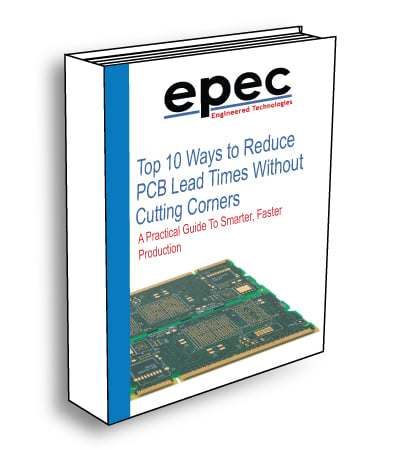PCB Manufacturing Process Capabilities
Printed circuit board technologies have changed rapidly over the past several years, pushing capabilities of standard production facilities and limiting what you can build and where you can build it. New technologies require new production equipment.
Providing quality PCB parts in a single standard production house is a thing of the past. Not all circuit board parts fit into one location. Knowing the capabilities within your supply chain and expanding your offering is not only an investment but necessary for survival in the PCB world. As more PCB manufacturing companies close domestically and across the world, a strong, reliable company with history is what you need.
Below you will find a list of PCB manufacturing process capabilities.
| Category | Description | Sym. | Capability |
|---|---|---|---|
1. Microvia Diameter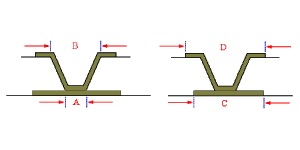 |
1.1 Microvia Diameter at Target Land |
A | 100 um 0.004" |
| 1.2 Microvia Diameter at Capture Land |
B | 125 um 0.005" |
|
| 1.3 Microvia Target Land Size |
C | 0.012" | |
| 1.4 Microvia Target Land Size |
D | 450 um 0.0177" |
|
2. Stagger & Stack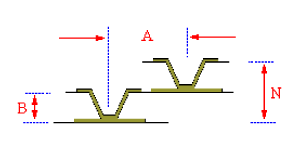 |
2.1 Min. Staggered Via Pitch Staggered Via Pitch |
A | 560 um 0.022" |
| 2.2 RCC Thickness RCC |
B | 50 um 0.002" |
|
| 2.3 Blind Via Layers |
N | 2 | |
3. Material & Construction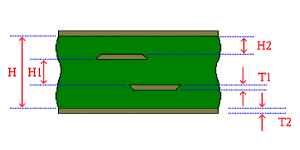 |
3.1 Finished Board Thickness |
H | 0.012" – 0.250" |
| 3.2 Min. Inner Layer Thickness |
H1 | 0.075 mm 0.003" |
|
| 3.3 Min. Dielectric Thickness |
H2 | 0.05 mm 0.002" |
|
| 3.4 Max. Inner Layer Copper |
T1 | 6 oz | |
| 3.5 Max. Outer Layer Copper |
T2 | 6 oz | |
4. Warp |
4.1 Warp & Twist (Max.) |
A B | < 0.75% |
5. Pad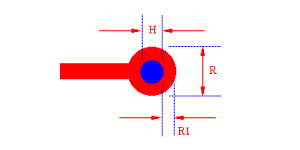 |
5.1 Min. Finish Hole Size |
H | 0.005" |
| 5.2 Min. Land Size |
H | 0.018" | |
| 5.3 Min. Annual Ring for Via |
R1 | IPC Class 2 | |
| 5.4 Min. Annual Ring for Component |
R1 | 0.05 mm 0.002", provided designed per IPC |
|
6. Drill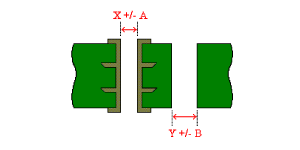 |
6.1 Tolerance for PTH Hole |
A | 0.08 mm 0.003" |
| 6.2 NPTH Hole Tolerance |
B | 0.05 mm 0.002" |
|
7. Registration for S/M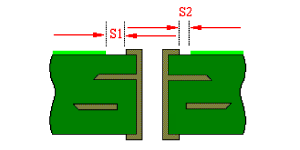 |
7.1 Registration for S/M to Pattern |
S1-S2 | 0.0024" |
| 7.2 Registration for Legend to S/M |
NA | 0.005" | |
8. Registration for Drill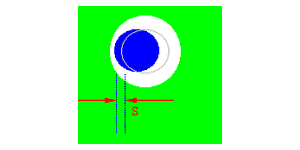 |
8.1 Registration for Drill to Inner Layer |
S | 0.075 mm 0.003" |
| 8.2 Registration for Drill to Datum |
S | 0.05 mm 0.002" |
|
| 8.3 Registration for First Drill to Second Drill |
NA | 0.005" | |
9. Registration for Layers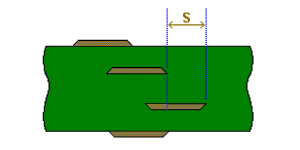 |
9.1 Layer to Layer for 4 layers |
S | 0.08 mm 0.003" |
| 9.2 Layer to Layer for 6 layers |
S | 0.10 mm 0.004" |
|
| 9.3 Layer to Layer for 8 layers |
S | 0.13 mm 0.005" |
|
10. Line Width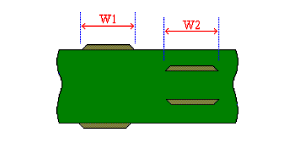 |
10.1 I/L Min. Width (0.5 oz) |
W2 | 0.003" |
| 10.2 O/L Min. Width (0.5 oz) |
W1 | 0.003" | |
11. Line Space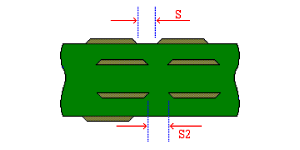 |
11.1 I/L Min. Space |
S2 | 0.003" |
| 11.2 O/L Min. Space (0.5 oz) |
S | 0.003" | |
12. Drill Capability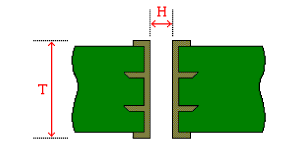 |
12.1 Max. Aspect Ratio (Board Thickness 0.063") |
H/T | 12.0 |
| 12.2 Min. Drill Hole Size (Board Thickness 0.063", After Plating) |
H | 0.0083 | |
13. S/M Thickness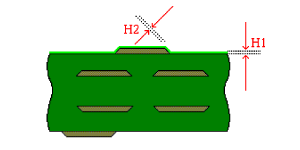 |
13.1 Max. Thickness on Copper |
H1 | 0.025 mm 0.001" |
| 13.2 Max. Thickness at Shoulder |
H2 | 0.0075 mm 0.0003" |
|
14. S/M Capability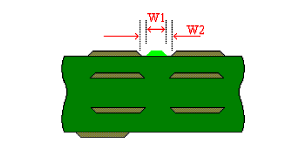 |
14.1 Min. SMD Space for Dam |
W2 | 0.0078" |
| 14.2 Min. Dam Size |
W1 | 0.004" 0.005" for white and black colors |
|
15. Carbon Capability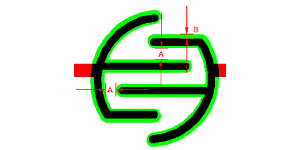 |
15.1 Max. Contact Resistance |
NA | 30 Ω / sq |
| 15.2 Max. Primary Resistance |
NA | 30 Ω | |
| 15.3 Min. Thickness |
NA | 0.0004" | |
| 15.4 Min. Space |
A | 0.015" | |
| 15.5 Max. Space for Registration |
B | 0.007" | |
16. HAL Capability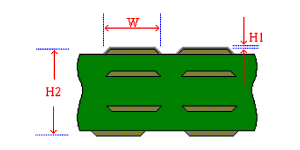 |
16.1 Min. PCB Thickness for HAL |
H2 | 0.6 mm 0.0236" |
| 16.2 Min. Pad Width/Space for HAL |
W | 0.25 mm 0.0098" |
|
| 16.3 HAL Thickness for any point |
H1 | 0.001 mm ~ 0.025 mm 40micro-inch ~0.001" |
|
| 16.4 Thickness on QFP Pad (0.05" Wide Quad) |
A | 0.015 mm ~ 0.030 mm 0.0006" ~0.0012" |
|
17. HAL Capability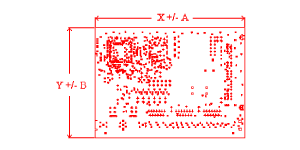 |
17.1 Outline Tolerance-Punching |
AB | NA |
| 17.2 Outline Tolerance-Routing |
AB | 0.005" | |
18. Beveling Capability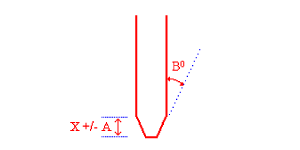 |
18.1 Beveling Angle |
B | 200-600 |
| 18.2 Tolerance for Outline of Bevel |
A | + - 0.005" | |
19. V-Cut Capability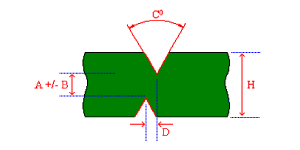 |
19.1 V-Cut Angle V-Cut |
C | 30° |
| 19.2 Range of Board Thickness |
H | 0.030"~0.125" | |
| 19.3 Tolerance of V-Cut Residual |
B | 0.05 mm 0.003" |
|
| 19.4 V-Cut Off Line V-Cut |
D | 0.125 mm 0.005" |
|
20. Test Capability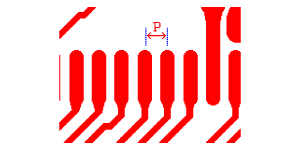 |
20.1 Voltage |
NA | 5 –500 VDC |
| 20.2 Isolation |
NA | 500 MΩ | |
| 20.3 Continuity |
NA | 20Ω~100KΩ | |
| 20.4 Min. SMD PAD Pitch SMD |
P | 0.3 mm 0.0118" |
|
21. Impedance Control Capability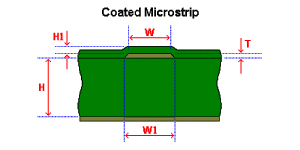 |
21.1 Impedance Control > 50O |
NA | +/- 10% |
| 21.2 Impedance Control < 50O |
NA | +/- 10% | |
22. Differential Impedance Capability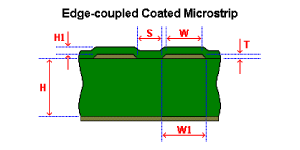 |
22.1 Differential Impedance Control > 50O |
NA | +/- 10% |
| 22.2 Differential Impedance Control < 50O |
NA | +/- 10% | |
23. Coplanar Impedance Capability |
22.1 Coplanar Impedance Control > 50O |
NA | +/- 10% |
| 22.2 Coplanar Impedance Control < 50O |
NA | +/- 10% |
Need An Advanced PCB Design Manufactured?
Upgrade your PCB production with our advanced capabilities. Stay ahead with precision and reliability. Get your custom quote now!
Request a Quote Request Design Support Request More Information

